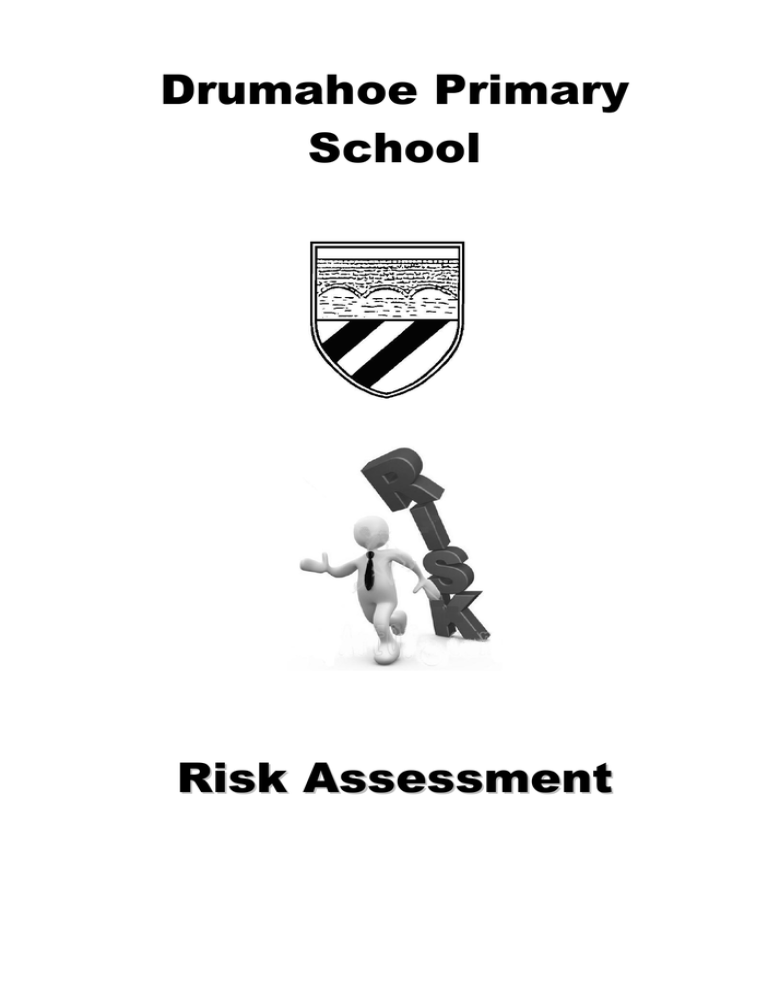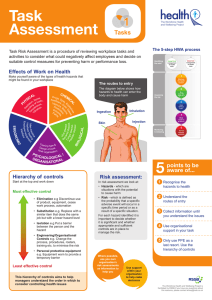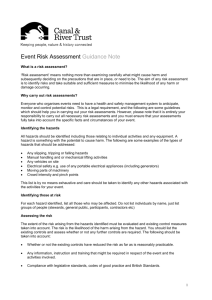Risk Assessment Policy - Drumahoe Primary School
advertisement

Drumahoe Primary School Risk Assessment Risk Assessment Policy INTRODUCTION This policy is designed to assist the school in fulfilling their legal duties in assessing risks. Risk management is the consideration of the risks that arise in the workplace and then putting in place sensible health and safety measures to control them. In accordance with our duties under the Management of Health and Safety at Work Regulations 2000, the school is required to undertake regular risk assessments and take any necessary action arising from these according to provisions set out in the Health and Safety policy and elsewhere. The Principal is responsible for making sure that risk assessments are completed, logged and effectively monitored. Reviews are conducted when there is any change to equipment or resources, any change to the school’s premises, or when particular needs of a child or other visitor necessitate this. The Principal is further responsible for conducting any necessary reviews or making changes to the school’s policies or procedures in the light of any potential risks that they or other members of staff discover. A visual inspection of both the equipment and the entire premises – both indoor and outdoor – will be carried out daily. This will, ordinarily, be carried out by a designated member of staff (Caretaker) on arrival at the school and will be completed before any children arrive. During the school day, staff will be vigilant and continuously aware of any potential risks to health and safety arising from: • the School’s environment, both indoors and outdoors; • all surfaces, both indoors and outdoors; • all equipment used by children or staff. On discovering a hazard, staff will take all steps necessary to making themselves and any other people potentially affected safe. They will then notify the Principal and ensure that a record is made in the Incident Record Book. The Principal is then responsible for ensuring that any necessary action is taken. As already stated, the Management of Health and Safety at Work Regulations (NI) 2000 require that suitable and sufficient assessments of the risk arising out of work are carried out. Put simply, a risk assessment is finding out what could cause harm to people and deciding if you have done enough or need to do more to protect them. The Process of Risk Assessment What can be risk assessed? A risk assessment can be undertaken on an object or substance, a process, a location, an activity, or a person. It is a five step process: Step 1: Identify the hazards Step 2: Decide who might be harmed and how Step 3: Evaluate the risks and decide on precautions Step 4: Record your findings and implement them Step 5: Review your assessment and update if necessary What is a hazard? A hazard is anything which can cause harm e.g. electricity, chemicals, etc What is risk? Risk is the chance, high or low, that somebody could be harmed by these and other hazards, together with an indication of how serious the harm could be. Evaluating the risk Having spotted the hazards, you then have to decide what to do about them. The law requires you to do everything ‘reasonably practicable’ to protect people from harm. You can work this out for yourself, but the easiest way is to compare what you are doing with good practice. There are many sources of good practice, for example HSENI’s website (www.hseni.gov.uk) CLEAPSS, etc. So first, look at what you’re already doing think about what controls you have in place and how the work is organised. Then compare this with the good practice and see if there’s more you should be doing to bring yourself up to standard. In asking yourself this, consider: Can I get rid of the hazard altogether? If not, how can I control the risks so that harm is unlikely? When controlling risks, apply the principles below, if possible in the following order: try a less risky option (e.g. switch to using a less hazardous chemical); prevent access to the hazard (e.g. by guarding); organise work to reduce exposure to the hazard (e.g. put barriers between pedestrians and traffic); issue personal protective equipment (e.g. clothing, footwear, goggles etc); and provide welfare facilities (e.g. first aid and washing facilities for removal of contamination). Involve staff, so that you can be sure that what you propose to do will work in practice. WHAT IS A RISK ASSESSMENT? The Health and Safety Executive (HSE) defines a risk assessment as “a careful examination of what in your work could cause harm to people so that you can weigh up whether or not you have taken enough precautions or should do more to prevent harm”. The assessment will help you to identify the likelihood of harm and whether you can reduce the risk to a reasonable level, through the introduction of control measures. The five step process is as follows: Step 1: Identify the hazards Divide your work into manageable categories considering: Location Activities Equipment People Identify the Hazards: Chemical – paint solvents/exhaust fumes Biological – bacteria Physical – noise/vibration Psychological – occupational stress Step 2: Decide who might be harmed and how For each hazard you need to be clear about who might be harmed, identify the groups of people – such as staff members or members of the public/pupils. Identify how they might be harmed i.e. what type of injury injury or ill health might occur. Step 3: Evaluate the risks and decide on precautions Consider how likely it is that each hazard will occur and what control measures you already have in place. Have the control measures in place got rid of the hazard altogether or reduced the risk so that harm is unlikely, if the task has not been adequately controlled what further actions are required. If any further actions are required the name of the person responsible for actioning the task should be recorded along with the projected completion date with the actual completion recorded in the completed column. Step 4: Record your findings and implement them Putting the results of your risk assessment into practice will make a difference when looking after our staff. Writing down the results of your risk assessment, and sharing them with the staff, encourages you to do this. Step 5: Review your assessment and update if necessary Risk assessments need to be reviewed and if necessary updated every year. However a review will be required sooner if an incident or accident occurs, or there are significant changes to the premises, staff or procedures. DEFINITION OF A HAZARD AND A RISK Hazard: A hazard is anything that may cause harm such as chemicals, electricity, working from ladders, an open drawer, etc. Risk: The risk is the chance, high or low, that somebody could be harmed by these and other hazards, together with an indication of how serious the harm could be. TYPES OF RISK ASSESSMENTS There are three different types of risk assessments. These are generic, specific and dynamic. Generic activities are those which although they are carried out at different times and locations, the hazards and risks are largely the same and do not change. For this type of activity generic risk assessments can be produced as a model for guidance only. A specific risk assessment may be applicable where the hazards and risks are only applicable to a certain activity and also where there is a requirement in legislation to undertake a specific assessment for example COSHH, new and expectant mothers. A dynamic risk assessment is a continuous process of identifying the hazards that occur in for example an emergency situation, assessing the risks and taking immediate action to eliminate or reduce these to an acceptable level. GENERIC RISK ASSESSMENTS This policy contains a generic risk assessment template which has been produced to assist our school with the risk assessment process and should form a good foundation for identifying hazards, assessing risks and implementing controls. However, you must also pay attention to our own school environment. The risk assessment template used is based on the format contained in the HSE publication “Five steps to risk assessment”, see Figure 1. The template should list the hazards identified in the school environment and their associated risks and also a range of control measures that should be in place to eliminate or reduce the risks. The form needs to be adapted by a competent person from our establishment, who can complete the rest of the form having considered the generic hazards, risks and control measures listed on the form and adding any site specific items identified. HOW TO ADAPT A GENERIC RISK ASSESSMENT 1. The person carrying out the assessment identifies which template is applicable to their particular activity. They would take the following steps: 2. Review the list of hazards within the “what are the hazards” box and decide if these are applicable to the task/activity. 3. Review the list of people and the consequences of the identified hazards in the “Who might be harmed and how” box and amend to suit individual school circumstances. 4. Review the list of control measures in place in the “What are you doing already” box and amend the list to reflect those procedures, safe working practices that have been implemented within the school. 5. A decision should then be made to determine whether the task/activity is adequately controlled. If additional control measures are identified these should be listed in the “What further action is necessary” box. If controls in place are deemed to be adequate then this box would remain empty. 6. When the “What further action is necessary” box is completed the name of the person assigned responsibility for ensuring that the control is put in place should be inserted in the “Action by who” box with a projected completion date added to the “Action by when” box. The actual completion date for any additional recommended measures should be recorded in the “Completed or Done” box. When actions/controls have been completed, the assessment form will need to be signed off by the person completing the assessment and forwarded to the Principal. Any action that cannot be closed off by the person carrying out the assessment should be brought to the attention of the appropriate person/s, e.g. building supervisor, Principal and a plan put in place to close out such actions. Some actions may be on‐going and this should be indicated in the “Action by when” box. It would be good practice that any action plan arising out of the risk assessment process is presented to the Board of Governors for their information, approval and action if required. The risk assessments will then need to be reviewed and if necessary updated, every year or so. A review will be required sooner if an incident or accident occurs, or there are significant changes to the premises, staff or procedures. FURTHER GUIDANCE If you require any further assistance with completing these generic risk assessments contact the Health and Safety Section. For guidance on carrying out risk assessments for curriculum activities please check the information available from the following sources: CLEAPSS School Science Service Laboratory Handbook www.cleapss.org.uk SAMPLE RISK ASSESSMENT School: Assessment carried out by: Activity: Outdoor play – Sunburn Date: Date of Review: What are the Hazards Who might be harmed and how? Existing Control Measures What are you already doing? What further action is necessary? Action by who? Action by when? Completed High Level of exposure to Sun Pupils, Staff -Sunburn -Dehydration Sunhats must be worn. Sun cream to be applied to pupils prior to arrival at School. Shaded play areas provided in outdoor playground. Outdoor play time limited as required. Staff are not permitted to apply sun cream to pupils. Pupils are not permitted to bring sun cream into school Drinking water available at all times Parents are informed of school procedures in relation to application of sun cream prior to the pupil beginning school and reminders are sent out at the beginning of third term Principal, parents and staff are to ensure pupils wear long sleeves on school trips Name of person responsible to be added here Realistic time frame to be added here Sign and date when further actions have been completed You may have other existing precautions you may wish to add You may have other further actions that you may wish to add SAMPLE RISK ASSESSMENT School: Assessment carried out by: What are the Hazards Defective flooring Slips, trips, falls Spilt food and liquids Slips, falls Broken Glass Cuts Obstacles Trips, falls Principal & Supervisory Staff Who might be harmed and how? Activity: Dining Hall Date: September 2012 Existing Control Measures What are you already doing? Inspection of flooring prior to use Prompt reporting and repair of defects Regular cleaning of floors in line with cleaning guidelines Prompt clearing of spillages Adequate signage Use of plastic items if possible Breakages cleared up promptly Chipped or damaged items discarded Walkways to be kept clear of bags etc. Adequate space allowed between tables for access Date of Review: What further action is necessary? You may have other further actions that you may wish to add Annual Action by who? Action by when? Completed Name of person responsible to be added here Realistic time frame to be added Sign and date when further actions have been completed Defective furniture Injury Hot food and liquid Scalds, burns Electrical equipment & sockets Electrocution Regular inspection routine with prompt remedial action Staff trained Trays provided Adequate supervision in relation to age of children Portable appliance testing and regular visual inspection Children informaed of good code of behaviour, no running, reporting all spills and no horseplay. You may have other existing precautions you may wish to add SAMPLE RISK ASSESSMENT School Outings Activity/Trip Location: Play Trail Assessment carried out by: Terry McMaster (Principal) Activity Date: 01.02.11 Date of Review:01.02.12 1.What are the hazards? 2. Who might be harmed 3. What are you already doing? Control measures at present 1. Child left behind at the School. Child Register taken before leaving School and head count on the bus. 2. Child not properly clothed for weather. Child Parents informed prior to trip and checks made on the arrival at School. Child 3. Child requires toilet on the way to the play trail Children taken to toilet prior to setting off. Child 4. Child needs toilet on arrival at trail Keys are obtained from school for toilet area on arrival Child 5. Child becomes ill whilst on outing 6. Child suffers from travel sickness Child Visit/ trip parental consent form taken with medical consent form and emergency contact numbers. First Aid kit taken. Children identified who suffer from travel sickness and seated appropriately on bus next to member of staff. Staff equipped with plastic bag, disinfectant wipes etc. 7. Dog fouling on play trail/ play area or broken glass Chiild/Staff Play Trail area checked prior to use. 8. Child becomes sunburnt Child Sun block ( Has parental consent obtained) applied and children to wear hats to protect from heat. 4. Further action required) (if any) Action by who? Action by when? Completed 9. Children become dehydrated Child Child/Staff Plenty of drinks taken and children encouraged to help themselves when they are thirsty. 10. Children/ staff have accident whilst on trip Child/Staff First Aid kit taken and first aider always present on trip. Emergency contact numbers taken. 11. Play Trail insecure resulting in intruder or child going missing The play trail fence and gates checked to see if secure. The risk assessment template will be reviewed yearly Date of Review: 01/09/13 Signature: SAMPLE GENERIC BLANK TEMPLATE



